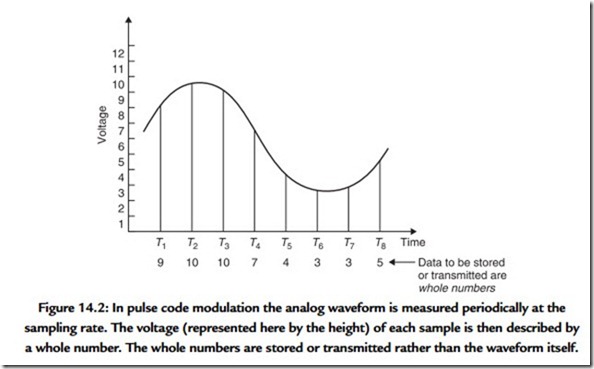What is an Audio Signal?
An analog audio signal is an electrical waveform that is a representation of the velocity of a microphone diaphragm. Such a signal is two dimensional in that it carries a voltage changing with respect to time. In analog systems, these waveforms are conveyed by some infinite variation of a continuous parameter. In a recorder, distance along the medium is a further, continuous analog of time. It does not matter at what point a recording is examined along its length, a value will be found for the recorded signal. That value can itself change with infinite resolution within the physical limits of the system.
Those characteristics are the main weakness of analog signals. Within the allowable bandwidth, any waveform is valid. If the speed of the medium is not constant, one valid waveform is changed into another valid waveform; a problem that cannot be detected in an analog system and that results in wow and flutter. In addition, a voltage error simply changes one valid voltage into another; noise cannot be detected in an analog signal. Noise might be suspected, but how is one to know what proportion of the received signal is noise and what is the original? If the transfer function of a system is not linear, distortion results, but the distorted waveforms are still valid; an analog system cannot detect distortion. Again distortion might be suspected, but it is impossible to tell how much of the energy at a given frequency is due to distortion and how much was actually present in the original signal.
It is a characteristic of analog systems that degradations cannot be separated from the original signal, so nothing can be done about them. At the end of a system a signal carries the sum of all degradations introduced at each stage through which it passed. This sets a limit to the number of stages through which a signal can be passed before it is useless. Alternatively, if many stages are envisaged, each piece of equipment must be far better than necessary so that the signal is still acceptable at the end. The equipment will naturally be more expensive.
Digital audio is simply an alternative means of carrying an audio waveform. Although there are a number of ways in which this can be done, there is one system, known as pulse code modulation (PCM), that is in virtually universal use.1 Figure 14.2 shows how PCM works.
Instead of being continuous, the time axis is represented in a discrete or stepwise manner. The audio waveform is not carried by continuous representation, but by measurement at regular intervals. This process is called sampling, and the frequency with which samples are taken is called the sampling rate or sampling frequency Fs. Each sample still varies infinitely as the original waveform did. To complete the conversion to PCM, each sample is then represented to finite accuracy by a discrete number in a process known as quantizing.
At the analog-to-digital convertor (ADC), every effort is made to rid the sampling clock of jitter, or time instability, so every sample is taken at an exactly even time step. Clearly, if there is any subsequent time base error, the instants at which samples arrive will be changed and the effect can be detected. If samples arrive at some destination with an irregular time base, the effect can be eliminated by temporarily storing the samples in a memory and reading them out using a stable, locally generated clock. This process is called time base correction and all properly engineered digital audio systems will use it.
Those who are not familiar with digital principles often worry that sampling takes away something from a signal because it appears not to be taking notice of what happened between the samples. This would be true in a system having infinite bandwidth, but no analog signal can have infinite bandwidth. All analog signal sources from microphones and so on have a resolution or frequency response limit, as indeed do devices such as loudspeakers and human hearing. When a signal has finite bandwidth, the rate at which it can change is limited, and the way in which it changes becomes predictable. When a waveform can only change between samples in one way, it is then only necessary to convey the samples and the original waveform can be unambiguously reconstructed from them.
As stated, each sample is also discrete or represented in a stepwise manner. The magnitude of the sample, which will be proportional to the voltage of the audio signal, is represented by a whole number. This process is known as quantizing and results in an approximation, but the size of the error can be controlled until it is negligible. The advantage of using whole numbers is that they are not prone to drift.
If a whole number can be carried from one place to another without numerical error, it has not changed at all. By describing audio waveforms numerically, the original information has been expressed in a way that is more robust.
Essentially, digital audio carries the sound numerically. Each sample is a numerical analog of the voltage at the corresponding instant in the sound.
